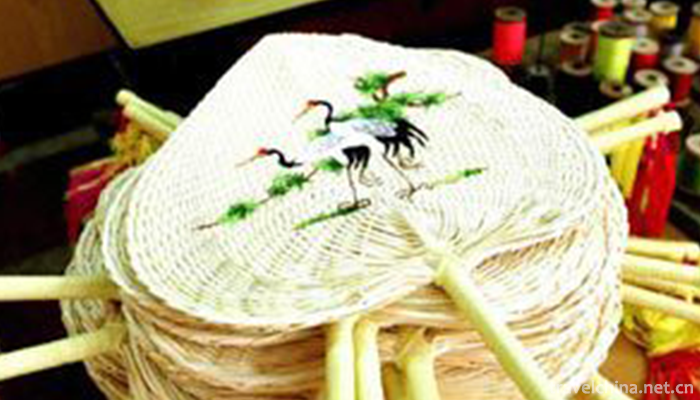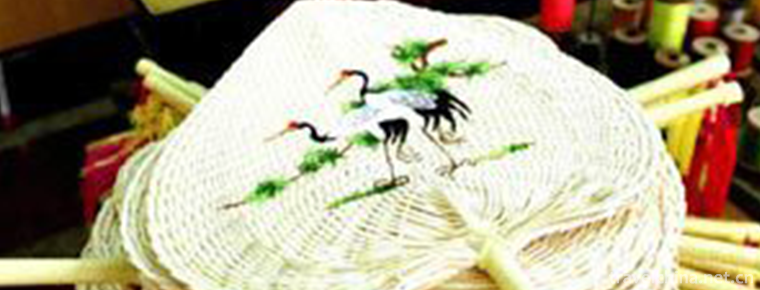Xinhui Sunflower Art
Xinhui Sunflower Art
Xinhui Sunflower Art, a traditional Chinese handicraft, originated in Xinhui District, Jiangmen City, Guangdong Province. Xinhui Sunflower Art has a history of more than 1600 years, and became famous internationally as early as the beginning of the 20th century. In 1915, Xinhui Bamboo Choice Sunflower Fan won the gold medal of Panama Expo. In 1988, Liao Huilin, then director of Xinhui Sunflower Artistic Products Factory, went abroad to participate in the Paris French Communist Festival to perform live Sunflower Artistic performances.
On June 7, 2008, Xinhui Kuiyi was listed in the second batch of national intangible cultural heritage list with the approval of the State Council.
Xinhui Sunflower Art is famous all over the world because it has superb plastic arts and exquisite knitting skills, and combines knitting, embroidery, painting, printing and other techniques in one furnace.
historical origin
Xinhui sunflower artwork is a well-known traditional Chinese handicraft. According to the Record of Xinhui County, during the Eastern Jin Dynasty 1600 years ago, Xinhui began to plant sunflower trees and process sunflower artwork. In the Qing Dynasty, Xinhui sunflower fans were sold well all over the country, and also exported to 24 countries and regions, such as Russia, Britain, the United States, France, Cuba, Colombia, Peru and Chile. At the end of the Qing Dynasty and the beginning of the Republic of China, the sales volume of Xinhui sunflower fans reached 120 million units per year.
As early as the early 20th century, Xinhui Sunflower Art became famous internationally. In 1915, Xinhui Bamboo Choice Sunflower Fan won the gold medal of Panama Expo. From July 1 to 7, 1958, Premier Zhou Enlai personally visited the New Society for in-depth investigation and inspection. During the week of the New Conference, Premier Zhou Enlai also visited the Sunflower Art Factory of Xinhui in a dusty manner. During his visit to the Sunflower Art Factory, he also kindly fanned sunflower artists, and the phrase "I am not a fan" still widely circulated in the New Conference. Come to work in the New Society, but come here to learn.
In the 1960s and 1970s, Xinhui Sunflower Art also created the economic value of "one step, three yuan". In 1975, the highest planting area was 30,000 mu, with an annual output of about 100 million sunflower fans, which became the pillar industry of Xinhui.
Production process
The process of making sunflower art is very complicated and meticulous. Generally speaking, from picking sunflower to making handicraft products, there are nearly 20 processes, such as cutting, drying, baking, cutting, bleaching, dyeing, knitting, crocheting or inlaying, printing and embroidery. It takes more than 10 people to make a sunflower artwork. From this, we can see that the art of Xinhui Sunflower is very precious.
Product Classification
Before liberation, due to the backward production technology and the domination of the gang feudal forces, the processing technology was conservative, the development of fancy varieties was slow, and the products were relatively single. Sunflower fans were mainly produced in the whole industry, and sunflower bones and awnings were also produced as by-products of three varieties. After thousands of years, it still stays in the mode of production of manual workshops. Under such backward production conditions, Xinhui Sunflower Workers still rely on hard work and wisdom to create a large number of exquisite handmade sunflower products.
After liberation, the craftsmen of Sunflower Art Factory carried out systematic research and trial production. In addition to inheriting the traditional crafts production, they constantly created new products. By the 1980s, there were more than 500 varieties of Sunflower Art products in Xinhui, which could be divided into three categories: sunflower fans, crafts and sunflower by-products.
Sunflower Fans
It refers to the fan made from sunflower leaves by cutting, sun drying, baking, baking, knitting and sewing. There are more than one hundred kinds of fans, such as cattle heart fan, chicken heart fan, glass fan, fire painting fan, bleaching embroidery fan, bamboo seal painting fan and glue weaving fan. According to the size of the model, it can be divided into large fan, medium fan, young fan and small fan. According to the quality of raw materials or manufactured sunflower fans, it can be divided into 1 to 4 grades.
Xinhui Sunflower Fan has always been famous for its round core, fine bone, white, flexible and smooth surface, and excellent knitting technology. Especially bamboo sheath painting fan, its processing needs four processes: knitting, drawing, portraying and sticking, all of which are meticulous work, and photolithography takes several days. This precious bamboo sheath painting fan used to be gifts and appreciation gifts given to each other by dignitaries and dignitaries. In 1915, he participated in the Panama Expo and won the honorary gold medal.
Fire Painting Fan
It is a kind of craft product with high requirement of painting technology in glass fan. It is said that the fire painting fan originated in the late Tongzhi period of the Qing Dynasty. At that time, the style of poetry, calligraphy and painting was more flourishing. Chen Yan, a famous painter in the New Society, cut and paste poetry and painting on glass fans, but it was not firm and would fall off when damped. It also developed the use of ink or pigments to draw poems directly on fans, but also easy to fade. Later, the poems and paintings painted on fans were burned with incense to show the poems and paintings. By the thirteenth year of Tongzhi (1874), he began to use iron pens to burn red in the fire, and then branded poems and paintings on the fan. Around 1914, when Liu Yiji Fanliao processed the spark fan, the technology developed. The method was to select two thin glass fans, first to cut off the backbone and handle of the fan, and then to synthesize a double-sided fan. In this way, both sides of the fan can be painted with a fountain pen. The edges of the fans were sewn with colored velvet and gradually developed into three-ridge and five-ridge fire painting fans with elegant style and elegant appearance. Fan handle also has a variety of decorations, useful bamboo. There are brown bamboo, Buddha belly bamboo, mottled bamboo and hedgerow bamboo. There are also ivory or rattan stalks. Film clips and sharp corners are used as nails. Among them, the ivory fire painting fan, with gorgeous decoration and noble value, is a fine collection of fans. Rich families use it as gifts for each other, and its products are well-known both at home and abroad.
Sunflower Basket
It is made from sunflower, sunflower leaf or sunflower vine by cutting, winding, weaving angle, trimming, claw ear, crochet or inlay, printing and other knitting processes. Sunflower basket has strong practicability and high ornamental. Some are shaped like backpacks, some are shaped like waistpacks, some are shaped like pots, some are shaped like pagodas, some are shaped like Palace lamps, lifelike, smooth lines, rich and colorful, exquisite craftsmanship, ingenious craftsmen.
Crafts
Including sunflower basket, sunflower hat, sunflower mat, sunflower mat, sunflower mat pillow mat, sunflower mat, car seat mat, sunflower curtain, sunflower mat, sunflower mat, sunflower disc, etc. And these products have many fancy varieties. There are nearly 300 flower varieties in sunflower baskets alone. Handicraft products are generally divided into 1 to 3 grades and inferior products according to the quality of manufactured products.
Sunflower by-products
Refers to sunflower products made from scrap material after cutting sunflower fans. Including sunflower claw tail, sunflower tie, sunflower bone, sunflower bone broom, sunflower bone hand sweep, sunflower stalk rattan, sunflower canopy, sunflower brown broom, sunflower cow rope, and so on.
Sunflower Sofa Cushion
It is made of sunflower rattan by bleaching, dyeing and knitting. With pure and white sunflower rattan, cleverly weave into four-sided continuous, up-down, left-right, symmetrical rhombic pattern, diagonally connected rhombic pattern, appears regular and rhythmic; black and yellow pattern contrast is strong, highlighting the large area of pure and white sunflower rattan, the whole cushion color. The combination of black, yellow and white patterns, the transition and contrast of the three colors, make the rhombic patterns of repeated arrangement change and form several geometric patterns subtly, thus producing a beautiful decorative rhythm. It also uses "plum flower horn" pattern as the decorative edge, which adds the decorative beauty of cushion.
Inheritance Significance
With the development of the times, sunflower products are gradually replaced by industrial products, and the demand and sales of sunflower products are declining. Local people had hoped that Sunflower Art could be transformed into handicraft so that Sunflower Art could be continued. However, affected by market economy and social development, this road has become more and more difficult: sunflower planting area is decreasing year by year, Sunflower Art talents are becoming scarce, and Sunflower Art in Xinhui is increasingly facing the crisis of disappearance.


-
1.Tiantai Mountain Scenic Area
Tiantai Mountain Scenic Spot, National AAAAA Class Tourist Spot, National Key Scenic Spot, One of China's Top Ten Famous Mountains, National Eco-tourism Demonstration Zone, Zhejiang Top Ten Tourist Sp
Time 2018-12-07 -
2.Dayan Pagoda Datang Furong Garden Scenic Area
The Furong Garden of the Tang Dynasty is located in Qujiang Development Zone in the south of Xi'an City, Shaanxi Province, on the southeast side of the Big Wild Goose Pagoda.
Time 2018-12-12 -
3.Expo Area of Acient Kiln Folk Cultures in Jingde
Jingdezhen Ancient Kiln Folklore Expo Area, located in Fengshu Mountain and Panlonggang, Changjiang District, Jingdezhen City, Jiangxi Province, covers an area of 83 hectares. It is a cultural tourist
Time 2019-01-12 -
4.Zaozhuang Old Street Shuicheng South Shandong
Shuicheng Zaozhuang Old Street in Southern Shandong Province is located in the middle section of Xichang Road in the Central District of Zaozhuang City, Shandong Province.
Time 2019-02-06 -
5.Zhangye National Wetland Park
Zhangye National Wetland Park is located in the northern suburbs of Ganzhou District, Zhangye City, which is closely linked with the urban area. Wetland area of 62,000 mu, the main body is located in
Time 2019-03-16 -
6.Making Skill of Roe Skin of Oroqen Nationality
The Oroqen nationality is one of the minorities with the smallest population in Northeast China. Because of the influence of living environment and customs, people of the Oroqen nationality
Time 2019-04-28 -
7.GA Da Meilin
Gadamelin (1892 - April 5, 1931), Mongolian, surname Molettu (translated into Chinese as Meng), Nadamud, Han name Meng Qingshan, also known as Yexi, Mongolian legendary hero. Born in Zhelimu League
Time 2019-04-30 -
8.Nu Fairy Festival
Fairy Festival is a traditional folk festival of Nu people in Gongshan area of Yunnan Province. The local flower festival, also known as the Flower Festival, is held on March 15 of the lunar calendar
Time 2019-06-08 -
9.Linear cavity
Line-tune opera, also known as Line-score opera, is an ancient traditional opera in Shanxi Province. It first appeared in the Han and Tang Dynasties, and developed greatly. It flourished in the Song D
Time 2019-07-03 -
10.Yi Kezhi
Yi Kezhi is a popular oral literature of poetry style among the Yi people. It is the cultural accumulation formed by the Yi people in their long-term production and life, and has a very long history.
Time 2019-07-12 -
11.Han Yu
Han Yu (768 - 824 December 25th) retreated. Henan Heyang (now Henan Province Mengzhou People. Claiming to be "Changli," the world is called "Han Changli" and "Mr. Changli"
Time 2019-09-07 -
12.History of Dazhou
Dazhou area belonged to Liangzhou in Xia Dynasty and Yongzhou in Yin Dynasty. The earliest indigenous people were the Cong people, who established the state of Cong (now tuxi Town, Quxian county). In the early Warring States period, Ba people migrated fro
Time 2020-12-20